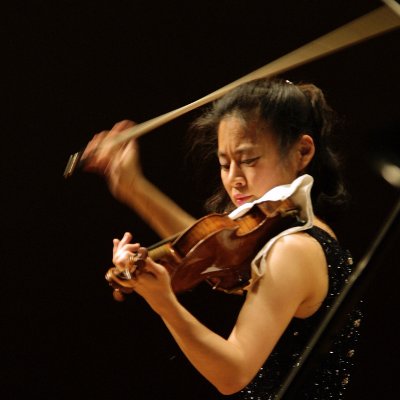Midori shows first-class artistry in rich program at Ravinia
Midori is one of those artists whose consistency, technical excellence and lack of interpretive excess can sometimes allow her gifts to be taken for granted.
Yet, as shown in her well-balanced program Monday night at Ravinia, Midori remains an artist of the very first rank, bringing an intensity, poetic eloquence and fizzing bravura to a varied array of works. Pianist Ozgur Aydin was her simpatico keyboard partner.
The evening framed two fascinating, Impressionistic 20th-century works with sonatas by Beethoven and Brahms.
Beethoven’s Sonata No. 4 made an admirable curtain-raiser. Unusual in structure with a Presto opening and a middle movement that combines slow section and scherzo, the A-minor sonata was the first of Beethoven’s ten works in the genre to display the young master’s originality.
Midori and her superb pianist put across an uncommonly fresh and vital performance that yet retained a Classical poise and gracious element. In the Andante, Midori brought a wry teasing lilt to the main theme, and the finale had fine drive and light virtuosity in a performance that conveyed the quirky humor without inflating the drama or scale.
Ernest Bloch’s music remains unaccountably neglected, so it was an inspired programming choice to offer his Violin Sonata No. 2. Born in Switzerland and later becoming an American citizen, Bloch often drew upon his Jewish roots. Yet his Second Sonata, subtitled Poeme mystique, seems more imbued with the spirit of Scriabin, Debussy and Symanowski.
Midori tackled Bloch’s sonata with a passionate, almost physical intensity without sacrificing an essential tonal grace and elegance, even in this most florid of works. The long single movement can seem episodic, but Midori materfully held the broad canvas together, the music unfolding, ballad-like, in a single breath. The violinist and her pianist conveyed the tart folk element and surging rhapsodic qualities while giving the music’s austere, brooding expression its due with finely colored and dynamically detailed playing. The performance culminated in a powerful coda, Midori and Aydin’s full-tilt advocacy making one wonder why this terrific work has yet to enter the regular fiddle repertory.
If anything, Midori’s impassioned commitment and technical gleam were even more daunting in Szymanowski’s Mythes. These “three poems for violin and piano” were written by the Polish composer in close collaboration with his violinist compatriot Pavel Kochanski, for whom Szymanowski also wrote his two violin concertos. The music is wild and Impressionistic, also breathing some of the perfumed sensuality of Scriabin but with a sharper edge and even more mercurial chromaticism.
Midori conveyed the surging drive of these works as well as the arboreal Classicism, as in the barely audible trills and tremolos of La fontaine d’Arthuse. The violinist also maintained admirable concentration in the evocative solo line of the central Narcisse, even with loudly dropped programs and oblivious candy-chewing audience members. The final section, Dryades et Pan, was a tour de force from the rustle of the quarter-tone wind trills to the frenzied dance section, Midori and Aydin putting across the picturesque qualities of this evocative and difficult score.
Only Brahms’ Violin Sonata No. 3 in D minor provided mixed rewards. The violinist brought apt fire and intensity to the final agitato movement, yet the opening Allegro felt a bit slender for Brahms, needing more weight and sonority. So too, while the Adagio—one of Brahms’ most indelible inspirations—was rendered with acute sensitivity, Midori here seemed to be marginally over-interpreting, with dynamic drops and excessive detailing when a more flowing and naturally expressive approach would have sufficed.
Her encore of Wieniawski’s Souvenir de Moscow could have smiled a bit more, but Midori showed she can toss off the glittery bon-bons with the best of them vaulting through the high harmonics and complexities with apparent ease.
Posted in Performances




